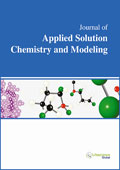jascm
Abstract : Polymeric Versus Lipid Nanoparticles: Comparative Study of Nanoparticulate Systems as Indomethacin Carriers (3)
|
|
Abstract: Encapsulation of nonsteroidal or non-steroidal anti-inflammatory drugs (NSAID) in nanocarrier systems aims to enhance bioavailability and to decrease toxicity of these drugs and thus improve the efficacy of treatments. With this aim two types of nanoparticles were prepared and compared: lipid nanoparticles, made of cetyl palmitate and Miglyol 812 which were uncoated or coated with chitosan; or polymeric nanoparticles, made of poly (DL-lactic-co-glycolic acid) (PLGA) for which different emulsion stabilizers were also tested (poly (vinyl alcohol) (PVA), and Pluronic F68). Nanoparticles were characterized for drug content and for particle size, charge and morphology. The lipid matrix was analyzed regarding its crystallinity by differential scanning calorimetry (DSC). The size of the nanoparticles was measured by dynamic light scattering (DLS) which indicated a unimodal particle size distribution in all systems. Nanoparticles’ stability was confirmed by their highly negative surface charge in the case of polymeric and uncoated lipid nanoparticles, as analyzed by zeta potential measurements using electrophoretic light scattering (ELS). Lipid chitosan coated nanoparticles have also shown to be stable presenting highly positive surface charge. Results have further demonstrated that indomethacin is highly encapsulated regardless the type of particles. Morphological analysis by scanning electron microscopy has shown that the nanoparticles were smooth and spherical. The results gathered within the current study point to the conclusion that the proposed formulations provide nanoparticles of satisfactory quality to encapsulate indomethacin, which might be used to improve bioavailability of other NSAID in the treatment of inflammation. Keywords: NSAID, PLGA nanoparticles, nanostructured lipid carriers (NLC), encapsulation efficiency, dynamic and electrophoretic light scattering (DLS and ELS), differential scanning calorimetry (DSC), electron scanning microscopy (SEM). Download Full Article |
Abstract : Polymeric Versus Lipid Nanoparticles: Comparative Study of Nanoparticulate Systems as Indomethacin Carriers (4)
|
|
Abstract: Encapsulation of nonsteroidal or non-steroidal anti-inflammatory drugs (NSAID) in nanocarrier systems aims to enhance bioavailability and to decrease toxicity of these drugs and thus improve the efficacy of treatments. With this aim two types of nanoparticles were prepared and compared: lipid nanoparticles, made of cetyl palmitate and Miglyol 812 which were uncoated or coated with chitosan; or polymeric nanoparticles, made of poly (DL-lactic-co-glycolic acid) (PLGA) for which different emulsion stabilizers were also tested (poly (vinyl alcohol) (PVA), and Pluronic F68). Nanoparticles were characterized for drug content and for particle size, charge and morphology. The lipid matrix was analyzed regarding its crystallinity by differential scanning calorimetry (DSC). The size of the nanoparticles was measured by dynamic light scattering (DLS) which indicated a unimodal particle size distribution in all systems. Nanoparticles’ stability was confirmed by their highly negative surface charge in the case of polymeric and uncoated lipid nanoparticles, as analyzed by zeta potential measurements using electrophoretic light scattering (ELS). Lipid chitosan coated nanoparticles have also shown to be stable presenting highly positive surface charge. Results have further demonstrated that indomethacin is highly encapsulated regardless the type of particles. Morphological analysis by scanning electron microscopy has shown that the nanoparticles were smooth and spherical. The results gathered within the current study point to the conclusion that the proposed formulations provide nanoparticles of satisfactory quality to encapsulate indomethacin, which might be used to improve bioavailability of other NSAID in the treatment of inflammation. Keywords: NSAID, PLGA nanoparticles, nanostructured lipid carriers (NLC), encapsulation efficiency, dynamic and electrophoretic light scattering (DLS and ELS), differential scanning calorimetry (DSC), electron scanning microscopy (SEM). Download Full Article |
Abstract : Preferential Solvation of the Antioxidant Agent Daidzein in some Aqueous Co-Solvent Mixtures according to IKBI and QLQC Methods (2)
|
|
Abstract: The preferential solvation parameters by ethanol (EtOH) or propylene glycol (PG) of daidzein were derived from their solution thermodynamic properties by means of the inverse Kirkwood-Buff integrals and the quasi-lattice-quasi-chemical (QLQC) methods. According to IKBI method, the preferential solvation parameter by the co-solvent, δx1,3, is negative in water-rich mixtures but positive in co-solvent-rich mixtures in both kinds of systems. This could demonstrate the relevant role of hydrophobic hydration around the aromatic rings in the drug solvation in water-rich mixtures. Furthermore, the more solvation by co-solvent in co-solvent-rich mixtures could be due mainly to polarity effects and acidic behavior of the hydroxyl groups of the compound in front to the more basic solvents present in the mixtures, i.e. EtOH or PG. Otherwise, according to QLQC method, this drug is preferentially solvated by the co-solvents in all the mixtures in both kind of systems. Keywords: Daidzein, ethanol, propylene glycol, preferential solvation, inverse Kirkwood-Buff integrals, quasi-lattice-quasi-chemical. Download Full Article |
Abstract : Effect of Operating Conditions of the Extraction Process on the Physical Properties of Lubricating Oil
|
|
Abstract: Lubricating base oil is commonly extracted from lube-oil cut, a petroleum cut, with the use of an aromatic solvent. Aromatic content of the final product is an important criterion specifying the product quality. The aromatic removal process to produce the lubricating oil should be carried out in a Liquid-Liquid extraction column. In a typical solvent extraction process, solvent to feed ratio, solvent and feed temperatures, agitation rate, and settling time could directly affect the yield of extraction. In the current study, the effect of agitation rate and settling time on the yield of extraction was studied. It was found that a settling time of 2hrs and an agitation rate of 430 RPM to be the optimum parameters of the extraction process. Keywords: Lubricating oil, Liquid-Liquid Extraction, Optimization.Download Full Article |






















